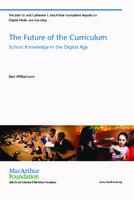The Future of the Curriculum
School Knowledge in the Digital Age
| dc.contributor.author | Williamson, Ben | |
| dc.date.accessioned | 2019-01-17 23:55 | |
| dc.date.accessioned | 2018-12-01 23:55:55 | |
| dc.date.accessioned | 2019-01-21 12:03:41 | |
| dc.date.accessioned | 2020-04-01T10:58:27Z | |
| dc.date.available | 2020-04-01T10:58:27Z | |
| dc.date.issued | 2013 | |
| dc.identifier | 1004026 | |
| dc.identifier | OCN: 1051076090 | en_US |
| dc.identifier.uri | http://library.oapen.org/handle/20.500.12657/26059 | |
| dc.description.abstract | An examination of curriculum innovations that are shaped by new ideas about digital media and learning.Although ideas about digital media and learning have become an important area for educational research, little attention has been given to the practical and conceptual implications for the school curriculum. In this book, Ben Williamson examines a series of contemporary curriculum innovations in the United States, Great Britain, and Australia that reflect the social and technological changes of the digital age. Arguing that the curriculum is always both forward- and rearward-looking, Williamson considers how each of these innovations represents a certain way of understanding the past while also promoting a particular vision of the future.The curriculum initiatives are all examples of what Williamson calls “centrifugal schooling,” expressing a vision of education and learning that is decentered, distributed, and dispersed, emphasizing networks and connections. In centrifugal schooling, a curriculum is actively assembled and improvised from a heterogeneous mix of people, groups, coalitions, and institutional structures. Participants in curriculum design and planning include local governments, corporations, foundations, charities, and nongovernmental organizations. Among the curriculum innovations Williamson examines are High Tech High, a charter school network in San Diego that integrates technical and academic education; Opening Minds, a “competence-based” curriculum used in 200 British secondary schools; and Quest to Learn, a “school for digital kids” in New York City (with a sister school in Chicago). He also describes two major partnerships: the Partnership for 21st Century Skills, which advocates for “21st century readiness” for American students; and the Whole Education Alliance in Britain, a network of “third sector” educational organizations. | |
| dc.language | English | |
| dc.subject.classification | thema EDItEUR::J Society and Social Sciences::JN Education::JND Educational systems and structures::JNDG Curriculum planning and development | en_US |
| dc.subject.classification | thema EDItEUR::P Mathematics and Science::PD Science: general issues::PDR Impact of science and technology on society | en_US |
| dc.subject.other | education | |
| dc.title | The Future of the Curriculum | |
| dc.title.alternative | School Knowledge in the Digital Age | |
| dc.type | book | |
| oapen.relation.isPublishedBy | f49dea23-efb1-407d-8ac0-6ed2b5cb4b74 | |
| oapen.relation.isbn | 9780262518826 | |
| oapen.pages | 152 | |
| oapen.place.publication | Cambridge | |
| oapen.remark.public | 21-7-2020 - No DOI registered in CrossRef for ISBN 9780262315197 | |
| oapen.identifier.ocn | 1051076090 |

